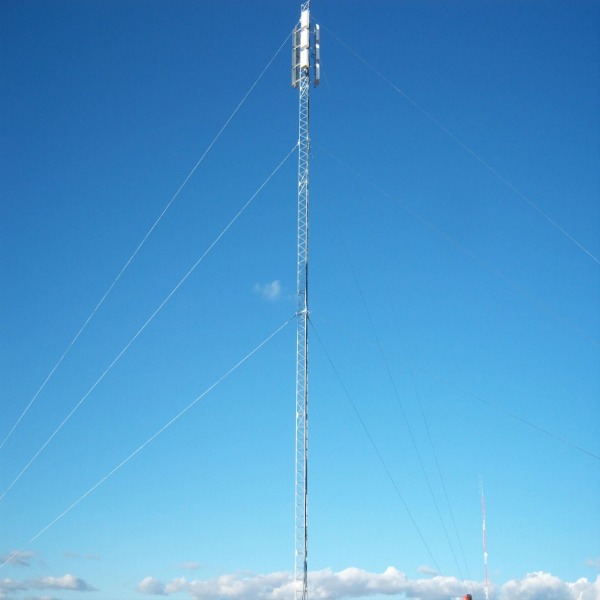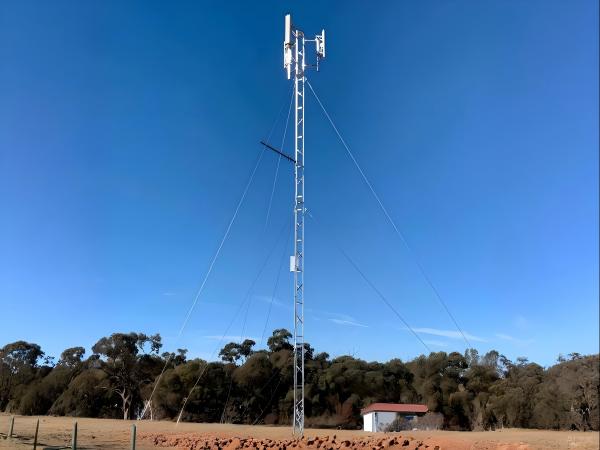The Physics of Stability
While self-supporting towers rely on rigid foundations to resist wind loads, guyed mast towers leverage a triangular tension system to achieve unparalleled stability:
Dynamic Load Distribution: Guy wires convert lateral wind forces (up to 150 km/h) into vertical tension, reducing tower shaft stress by 60% versus self-supporting designs.
Anti-Overturning Mechanism: Each wire anchor acts as a pivot point, creating counter-moments that neutralize torsion during storms. At 40m height, a 3-anchor system provides 360° load balancing with just 25% steel usage of lattice towers.

Wind Load Performance Comparison
| Tower Type | Max Wind Resistance | Material Cost | Foundation Depth |
|---|---|---|---|
| Self-Supporting | 130 km/h | $28,000 | 3.5m |
| Guyed Tower | 150 km/h | $11,200 | 1.2m |
(Data: ITU-R F.1507 standards / Huawei rural deployment cases)
1. Rural Blanket Coverage (e.g., Indian Plains)
100km² Coverage per Tower: 40m guyed towers achieve 45dB UHF signal strength across flat terrain using 700MHz band.
Cost Efficiency: Nigeria's Phase III National Broadband Plan deployed 12,000 guyed towers at $9.3k/unit – 58% cheaper than alternatives.
2. Mountainous Signal Relay (e.g., Peruvian Andes)
Slope Adaptability: Guy anchors secure to bedrock at 30° inclines where concrete foundations fail.
Signal Hopping: Chile's ENTEL uses cascaded guyed towers (15km spacing) to penetrate canyons, achieving 94% 4G availability in remote villages.
3. Disaster-Prone Economies (e.g., Indonesian Islands)
Typhoon Resilience: After 2021 Cyclone Seroja, Timor-Leste's guyed-tower networks suffered <8% downtime vs 67% for monopoles.
Rapid Deployment: Philippine's emergency comms units erect 30m towers in 4 hours using helicopter-transportable kits.

Bangladesh's "Digital Island" project demonstrates operational savings:
\begin{align*}
\text{Total Cost of Ownership} &= \text{CapEx} + 10\text{-year OpEx} \\
\text{Self-supporting} &= \$43k + \$96k = \$139k \\
\text{Guyed Tower} &= \$17k + \$31k = \color{green}{\$48k}
\end{align*}
Savings enable 3x more sites per budget – critical for universal service obligations.
Urban Microcells: Land constraints make anchor footprints (20m dia.) impractical
Multi-Operator Sites: Limited top-platform space struggles beyond 6 antennas
Vandalism-Prone Areas: Exposed guy wires require tamper-proof monitoring
The Verdict
Guyed towers aren't just "cheap" – they're strategically optimized for UHF's long-range physics. By marrying tensile efficiency with terrain flexibility, they deliver coverage where traditional towers can't compete. As 5G expands into unserved territories, these unsung heroes will remain the backbone of inclusive connectivity.
For project planners: Prioritize hot-dip galvanized steel (ISO 1461) and helical screw anchors in sandy soils. Always budget for tension monitoring systems – loose guys cause 73% of failures.
Learn more at www.alttower.com